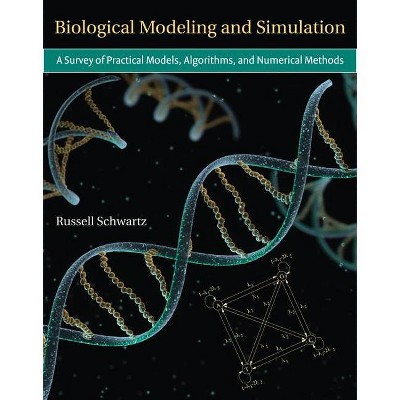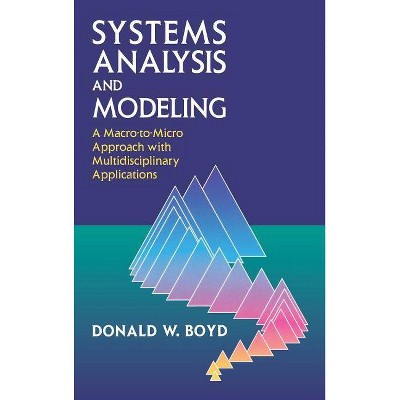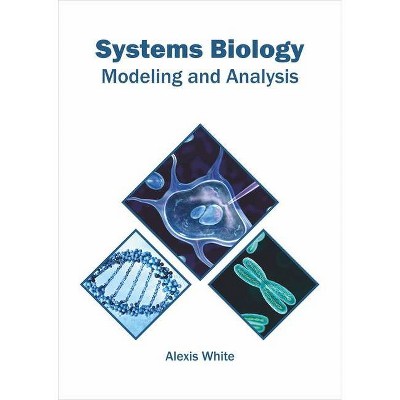Modeling Biological Systems: - 2nd Edition by James W Haefner (Hardcover)

Similar Products
Products of same category from the store
AllProduct info
<p/><br></br><p><b> Book Synopsis </b></p></br></br>I Principles 1 1 Models of Systems 3 1. 1 Systems. Models. and Modeling . . . . . . . . . . . . . . . . . . . . 3 1. 2 Uses of Scientific Models . . . . . . . . . . . . . . . . . . . . . . . . 4 1. 3 Example: Island Biogeography . . . . . . . . . . . . . . . . . . . . . 6 1. 4 Classifications of Models . . . . . . . . . . . . . . . . . . . . . . . . 10 1. 5 Constraints on Model Structure . . . . . . . . . . . . . . . . . . . . . 12 1. 6 Some Terminology . . . . . . . . . . . . . . . . . . . . . . . . . . . 12 1. 7 Misuses of Models: The Dark Side . . . . . . . . . . . . . . . . . . . 13 1. 8 Exercises . . . . . . . . . . . . . . . . . . . . . . . . . . . . . . . . 15 2 The Modeling Process 17 2. 1 Models Are Problems . . . . . . . . . . . . . . . . . . . . . . . . . . 17 2. 2 Two Alternative Approaches . . . . . . . . . . . . . . . . . . . . . . 18 2. 3 An Example: Population Doubling Time . . . . . . . . . . . . . . . . 24 2. 4 Model Objectives . . . . . . . . . . . . . . . . . . . . . . . . . . . . 28 2. 5 Exercises . . . . . . . . . . . . . . . . . . . . . . . . . . . . . . . . 30 3 Qualitative Model Formulation 32 3. 1 How to Eat an Elephant . . . . . . . . . . . . . . . . . . . . . . . . . 32 3. 2 Forrester Diagrams . . . . . . . . . . . . . . . . . . . . . . . . . . . 33 3. 3 Examples . . . . . . . . . . . . . . . . . . . . . . . . . . . . . . . . 36 3. 4 Errors in Forrester Diagrams . . . . . . . . . . . . . . . . . . . . . . 44 3. 5 Advantages and Disadvantages of Forrester Diagrams . . . . . . . . . 44 3. 6 Principles of Qualitative Formulation . . . . . . . . . . . . . . . . . . 45 3. 7 Model Simplification . . . . . . . . . . . . . . . . . . . . . . . . . . 47 3. 8 Other Modeling Problems . . . . . . . . . . . . . . . . . . . . . . . . 49 viii Contents . . . . . . . . . . . . . . . . . . . . . . . . . . . . . . . . 3. 9 Exercises 53 4 Quantitative Model Formulation: I 4. 1 From Qualitative to Quantitative . . . . . . . . . . . . . . . . . Finite Difference Equations and Differential Equations 4. 2 . . . . . . . . . . . . . . . . 4. 3 Biological Feedback in Quantitative Models . . . . . . . . . . . . . . . . . . . . . . . . . . 4. 4 Example Model . . . . . . . . . . . . . . . . . . . . . . . . . . . . . 4. 5 Exercises 5 Quantitative Model Formulation: I1 81 . . . . . . . . . . . . . . . . . . . . . . . . . . . 5. 1 Physical Processes 81 . . . . . . . . . . . . . . . 5. 2 Using the Toolbox of Biological Processes 89 . . . . . . . . . . . . . . . . . . . . . . . . . . . . 5. 3 Useful Functions 96 . . . . . . . . . . . . . . . . . . . . . . . . . . . . . . . . 5. 4 Examples 102 . . . . . . . . . . . . . . . . . . . . . . . . . . . . . . . . 5. 5 Exercises 104 6 Numerical Techniques 107 . . . . . . . . . . . . . . . . . . . . . . . 6. 1 Mistakes Computers Make 107 . . . . . . . . . . . . . . . . . . . . . . . . . . 6. 2 Numerical Integration 110 . . . . . . . . . . . . . . . . 6. 3 Numerical Instability and Stiff Equations 115 . . . . . . . . . . . . . .<p/><br></br><p><b> From the Back Cover </b></p></br></br><p>This extensively revised second edition of <em>Modeling Biological Systems: Principles and Applications</em> describes the essentials of creating and analyzing mathematical and computer simulation models for advanced undergraduates and graduate students. It offers a comprehensive understanding of the underlying principle, as well as details and equations applicable to a wide variety of biological systems and disciplines. Students will acquire from this text the tools necessary to produce their own models.</p> <p></p> <p>The text contains two major sections: Principles and Applications. The first section discusses the principles of biological systems with a thorough description of the essential modeling activities of formulation, implementation, validation, and analysis. These activities are illustrated by a set of example models taken from recent and classical literature, chosen for their breadth of coverage and current timeliness. The new edition updates extensively many of these topics, especially quantitative model formulation, validation and model discrimination using information theory measures and Bayesian probability, and stability analysis and non-dimensionalization.</p>
Price History
Price Archive shows prices from various stores, lets you see history and find the cheapest. There is no actual sale on the website. For all support, inquiry and suggestion messagescommunication@pricearchive.us




















